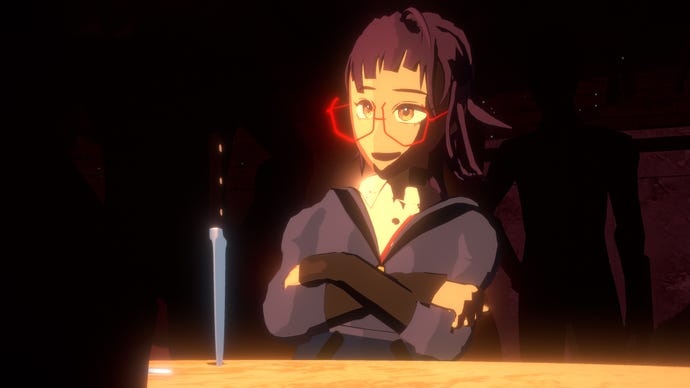Necrobarista Review: Death, Stranded
Is one life ever enough?
This article first appeared on USgamer, a partner publication of VG247. Some content, such as this article, has been migrated to VG247 for posterity after USgamer's closure - but it has not been edited or further vetted by the VG247 team.
Grief makes you think the darndest things. What more could I have done? Should I have not let work or other obligations get in the way of us hanging out? Could my actions have changed what happened—or at least made me feel less like I wasn't there for them? They're all selfish questions of course, but since I suffered the loss of a loved one earlier this year, it's been the first thing on my mind when I wake up and the last thing on my mind as I drift to sleep. Maddy, the main character of Necrobarista, is clouded by her own selfishness in the face of grief too.
Maddy is the owner of an interdimensional coffee shop called The Terminal. It's the last stop between our reality and the afterlife. A place for mortals to grab a cup of coffee, and for ghosts just passing through to idly hang before they embark to "the next place"—neither heaven nor hell. No one knows quite what lies beyond, only that "people" have about 24 hours to waste before officially passing on.
There are ways to elongate the move onward. The recently deceased can barter for more time, but the longer they stay, the more their soul gets "itchy" and uncomfortable. Some can't let go of their life, or maybe they're afraid of what's next. Over the years, The Terminal has collected an immense "soul debt" because of it: It's their job to nudge people out the door when it's their time to really die, but Maddy and Chay—the latter a close friend and mysteriously the former owner of the cafe—are content letting people take as much time as they need, even if it's to the detriment of the cafe.
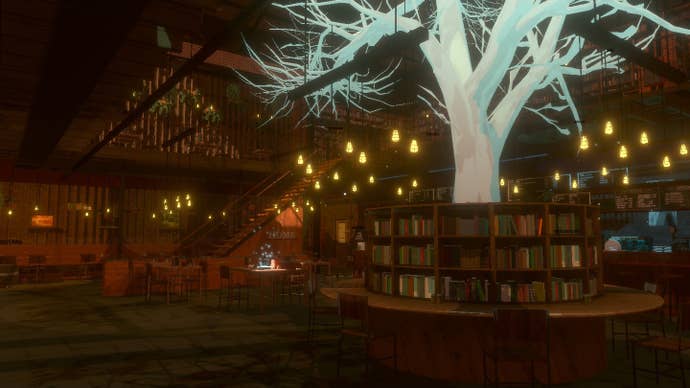
Necrobarista is a linear visual novel. There are no choices to be made. No different endings, or separate directions to steer the story into. Unlike other cafe-set visual novels, such as VA-11 Hall-A and Coffee Talk, Necrobarista doesn't even have you mixing drinks for customers. While initially this disappointed me, the stellar world-building, coupled with engaging characters and storytelling, made it an easy thing to forgive. Necrobarista is a game with a specific story to tell, and it wastes no time in telling it.
Its characters are what immediately drew me in. There's the aforementioned Maddy, who's a bit rude, but is immediately likeable nonetheless. There's Ashley, who's initially a comedic relief-sort of character—she throws knives at people for no decent reason, yells at everyone, and has a robotic arm—but as the game progresses, she opens up about her parents and why she loiters at the cafe all day. There's Chay and Ned, who each are literally thousands of years old, and have the baggage to match. (Ned is literally a historical figure: The famous Australian outlaw Ned Kelly.) And last but not least there's Kishan, who's in many ways the heart of Necrobarista. At first just another customer, he soon embeds himself into the cafe crew while waiting for the end to come in 24 hours time. For being a linear game without any sort of choice-making, which is uncommon for a visual novel, the characters remain easy to feel connected to anyways as they grow over the course of just one 24-hour day.
Necrobarista itself is structured in an interesting way. There are the usual visual novel "episodes," wherein the core story unfolds surrounding Maddy, Chay, Ashley, Kishan, and Ned, who is a member of The Council—a.k.a. the shadowy organization that act as soul debt collectors for places such as The Terminal. In most visual novels, character illustrations pop up as dialogue happens. In Necrobarista, the camera zips around the landscape, framing the cel-shaded 3D characters in striking ways. It grabs hold of its "cinematic" descriptor, and never lets go.
Video games, I believe, have a "direction" problem. To use a recent example: Ghost of Tsushima is a game heavily inspired by the chanbara genre, and yet its cutscenes barely seem to play with that particular cinematic style. Its cutscenes are framed like any other video game, with hardly any playful composition or other clever imagery. Meanwhile, Necrobarista is the opposite of this. It is 100% cinematic style with an anime-inspired lens, and with that pointed inspiration, knows exactly how to frame every screen in an interesting way.
A simple dialogue between two characters is never just two people standing side by side. It bounces from extreme close ups on faces, to distance shots with the characters looking small against the backdrop of the cafe. The angle might be oddly tilted, or peering through a crack from afar. The characters are nearly always still in these scenes, and hardly ever in motion. This all sets it apart from just about every visual novel, or even game, that I've ever played. The closest comparison I can think of is the work of Blendo Games, wherein developer Brendon Chung uses jarring smash cuts in the likes of Thirty Flights of Loving and Gravity Bone. Necrobarista shows that there's even more that can be done with cinematic language in games.
In-between these atypically "shot" episodes, players are given the opportunity to walk around The Terminal themselves in first-person. It's less a walking simulator, and more similar to the first-person exploration in an old Shin Megami Tensei game, or in the more recent Danganronpa series. Around The Terminal—and more spaces within it open up as the game progresses—there are short text adventures to read. The stories themselves help bring additional flavor not just to the world of Necrobarista, but to the day-by-day of how The Terminal runs and the customers it caters to. To unlock each text adventure, one needs to have points in what I can only describe simply as "key word categories" in their inventory.
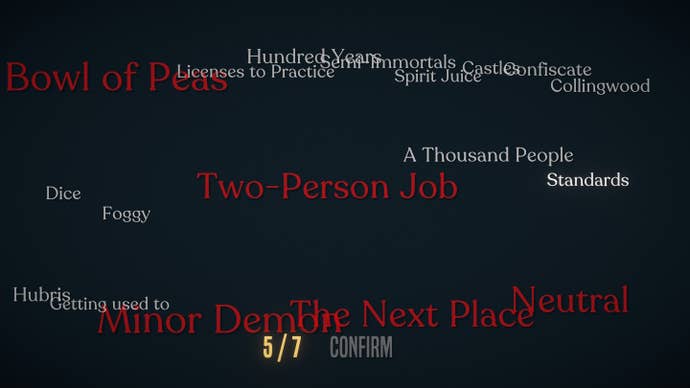
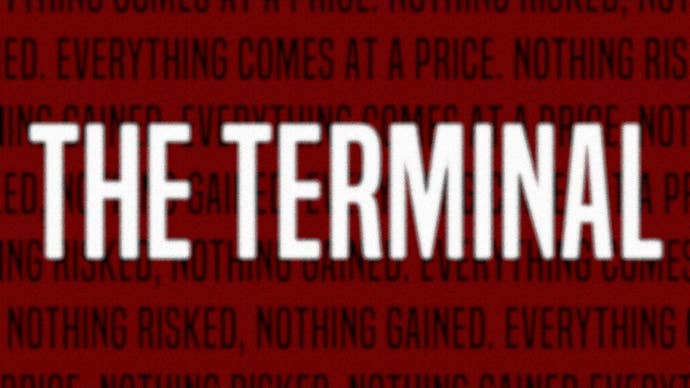
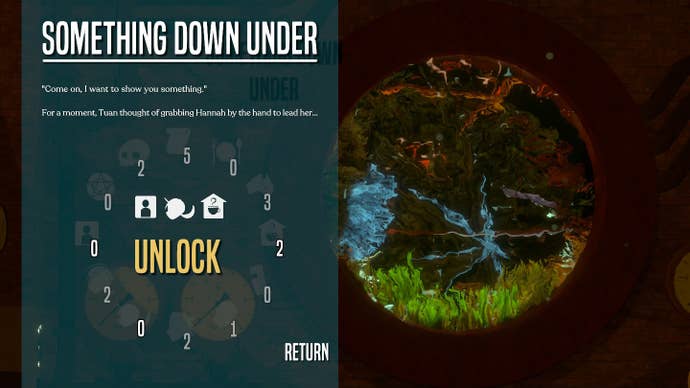

I unfortunately stumbled a bit with this system. Over the course of conversations in the episodic sections, a word or phrase is occasionally highlighted in yellow. Click on it, and there's a short glossary-like explanation, usually offering further context about whatever was said. These words show up at the end of each episode, floating around in a sort of word cloud. Then, it has you pick just seven of them.
The words funnel into one of a dozen categories, ranging from centering on characters, to locations in the world itself. The problem is: When I got to the end-of-episode word cloud, I could barely remember the context any of the phrases were said in. I couldn't recall who said it, nor why. This led to me just picking what words stuck out. The points accrued for the categories are then able to be spent on unlocking text adventures that are strewn across The Terminal. Alas, I only was able to experience a slim amount of them on my first playthrough, because I often found myself lacking one required category point to unlock a story. As a result I often had lopsided point totals, such as five points to spend on Melbourne-related stories with none of the other points necessary to actually unlock them.
It's an odd, obtuse system that locked me out of experiencing more of the story, which felt antithetical to the linear direction of the main story at hand. There's no replayability for Necrobarista in terms of its main story, but when it comes to unlocking these entertaining little text adventures, it's doubtful that one would be able to unlock all of them in a single playthrough. I sure didn't.
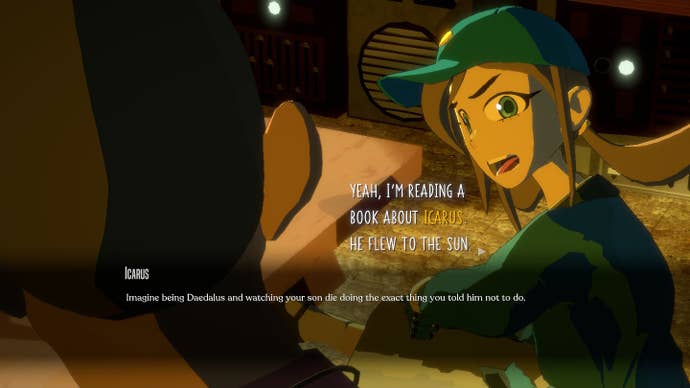
In the grand scheme of visual novels, perhaps this is a minor grievance. After all, most visual novels are designed to be replayed in order to see other endings and decisions. This is, really, just Necrobarista's own way of facilitating players to revisit its sweet, sad story.
Nevertheless, Necrobarista is a game that kept me hooked from start to finish, despite its lack of a choice-driven narrative. By the time it wrapped, I wanted to see more of the unique world it presented. I want to see Maddy interact with more customers, like the flirtatious Samantha, or the kleptomaniac teens. I want to see what was next for Ashley and her strange robotic arm. I want to learn more about The Council and the infrastructure of the in-between life, just like Kishan. I want to see other cafes or half-way purgatorial places like The Terminal, even. All considered, Necrobarista's story is one I deeply related to; every facet of its world had me fascinated. Necrobarista is the rare case that succeeds in both style and substance, like a fancy, overpriced latte.
ConclusionA distinct, cel-shaded and anime-inspired style isn't the only thing remarkable about Necrobarista. From its main story to the entertaining text adventures that paint between the lines of its more stylishly presented narrative, Necrobarista is an engaging visual novel from start to finish. Some minor complaints in how it executes unlocking additional text adventures does little to hold back the death-concerned coffee shop adventure.
